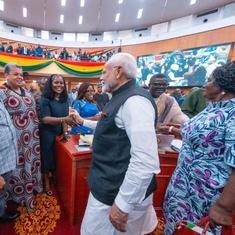But that might have been a case of premature celebration. Fear and anger are again stalking the hills.
Security camps of the Central Reserve Police Force have been mushrooming in this part of Kalahandi district. From one camp established five years ago, there are now three on the periphery of Niyamgiri. More are expected to come up.
Government officials cite rising Naxal activity as the reason for the security buildup. But among the tribal Kondhs, the increased paramilitary presence is leading to fears that the government is trying to force them off their land.
Kumti Majhi, an elder from the Kutia Kondh community, who emerged as one of the main leaders of the movement against mining in Niyamgiri, claimed the number of troops rose in response to the success of the movement. "The forces were sent from all over – Rayagada, Andhra, Kalahandi – so that the Kondh people leave the hills," he said. While the Dongria Kondhs live in the forest, the Kutia Kondhs live in the foothills.
In Kurli Komesh, a village on the fringes of Niyamgiri's forest, home to both Kondhs and Dalits, people said it had become difficult to venture out at night. In this area with poor roads and hardly any vehicles, most people walk to the nearby market or hospital. It is usually late by the time they get back. Often, the CRPF soldiers detain those walking back home at night and deposit them in police stations at Bissamcuttack or Rayagada. When someone is picked up, said a young man, “Village elders have to go to the stations and vouch the person picked up is not a Naxal.”
The interventions do not always prevent violence, people alleged. “Government forces beat villagers and put them in jail saying they are Naxals," said Majhi.
In an interview to KBK Samachar, a small independent collective of video journalists, Lado Sikoka, a young and articulate Kondh leader who lives in Lakhpadar village, made a similar charge. “When they (government forces) meet us, they beat us," he said. "They take away our local weapons. And they say things like 'Why work here? Go to Vedanta, you will get money for free.' But we do not want free money. Our God is here.”
False cases
In the past, leaders like Majhi had to deal with police complaints filed by the mining company. But now, the nature of police FIRs is changing. A local journalist, who spoke to Scroll on the condition of anonymity, explained, “At one time, the FIRs used to be lodged by the company against the protesters. But now, these are lodged by the state listing the leaders as Naxals.”
Take the FIR filed on July 28, 2011, at the police station at Muniguda, to the east of the Niyamgiri hills. It alleges that a man called Dadhi Sikoka was killed by the Naxals. The FIR names six people as accused and says they were accompanied by another 40-45 Naxals.
But the journalist identified only two of those six – Banti and Sukadev – as Naxals. “The others are Dongria Kondh leaders working in the movement,” he said.
One of them is Lado Sikoka. Said the journalist, “Lado is still in Niyamgiri. He moves around, meets the local administration. No one arrests him. It is just that his name is in the FIR.”
Majhi's name features in an FIR filed in February after a special police officer Deten Patnaik was allegedly killed by the Naxals. But the police have made no attempts to contact or interrogate him, the Kondh leader said. “Naam khali daala hain (They have simply put down my name)."
The journalist said that whenever the police wants to clamp down on protests, it can use the FIRs to put the leaders behind bars. “People like Lado Sikoka did not even know their names are in the FIRs," he said. "Har aadmi ke naam pe Naxal ka tag lag raha hain (They are branding everyone as Naxals)."
The government's defence
The Kondhs have been complaining about the excesses of security forces for over three years, well before the village meetings where it was decided to not allow mining operations. In an interview to the KBK Samachar in March 2012, Drangu Sikoka, a resident of Lakhpadar village, said he had been stripped, tied to a tree and beaten by government forces.
Surprisingly, despite the passage of three years, there has been no independent corroboration of these complaints. All three concerned officials – the collector of Kalahandi, the district's superintendent of police, and the inspector-general of the CRPF in Bhubaneswar – refuted the allegations of violations by the government forces.
Brajesh Kumar Rai, the police superintendent, pointed at the lack of specific complaints. “Tell us who is the victim? Is there a complainant? Has the press come out with any instances? What is the name of the perpetrator?” he asked.
The absence of a specific complaint showed there are no violations, said Piyush Anand, the CRPF inspector general in Bhubaneswar. “Security forces misbehaving anywhere is a big news. Why would this not become news, specially here?” According to Anand, the Kondhs are very well-connected politically. "Even the drop of a pin here gets heard in Delhi," he said.
Both Rai and Anand maintained the claims of police excess were nothing but Naxal propaganda.
In June, Kumti Majhi, the Kondh leader, had given a letter to the district collector complaining about harassment by the CRPF men. No enquiry had been launched into the complaint. Said D Brunda, the collector of Kalahandi, "This is a general complaint. It is not saying a particular person has done something. There are many CRPF people here so how do we initiate action?”
A copy of the letter could not be accessed, but Lingaraj Azad, a local activist who went with Majhi to submit it, confirmed that it did not mention specific names. Explaining why the names were skipped, he said: “The sangathan is fighting for all villages, not only for the affected ones. And so, we do not single out any particular village. Also, what happens in one village is likely to be happening in all."
This reasoning appears to have resulted in vague memorandums that the administration can ignore.
Difficulty in communication
The claims to their well-connectedness with Delhi notwithstanding, the Dongria Kondhs are one of the most vulnerable tribal groups in the country. "After they leave the forest, they lack the courage to speak," said the journalist. "They can speak in the meetings of their own but not before the administration."
This puts them at a disadvantage. “If you dealing with the government, you have to deal with it as per its processes," the journalist said.
An independent fact-finding mission might help in bridging this divide. But for now, it appears the Kondhs are stuck between the Naxals and the security forces. What this also underscores is the continuing vulnerability of Niyamgiri.
Supreme Court lawyer Prashant Bhushan explained, “The reason the (Vedanta) project was not allowed is because the local people did not want it. If they change their mind, and if the government submits that application again, it could be cleared.”
That said, Niyamgiri is not an isolated instance. Similar processes have been seen in other parts of the state earlier. Sudhir Pattnaik, an activist who also brings out a magazine on social issues called Samadrusti, pointed out that the majority of the areas that have declared Naxal-affected are rich in minerals. “There are more paramilitaries in the state now than six-years years ago," he said. "And the state is asking for more and more military camps here.”
According to him, the protest movements are being linked to Naxals to make it easier for the government to deal with them. “So far, people have been very firm but peaceful in their protests. You have to call them militant in order to crush them," said Pattnaik.
With the state economy slowing down as the mining boom peters out, the crackdown against grassroots activism could get more severe.










